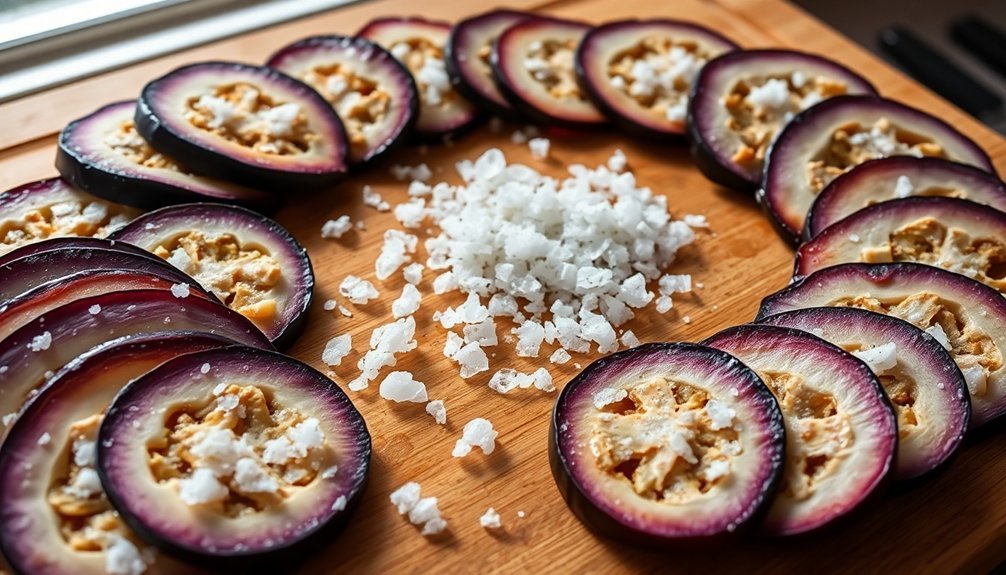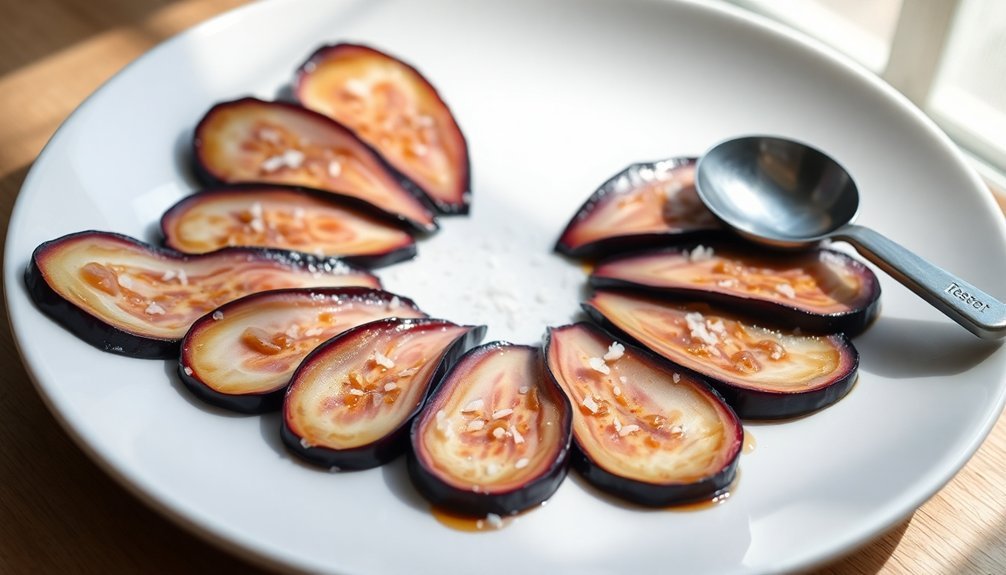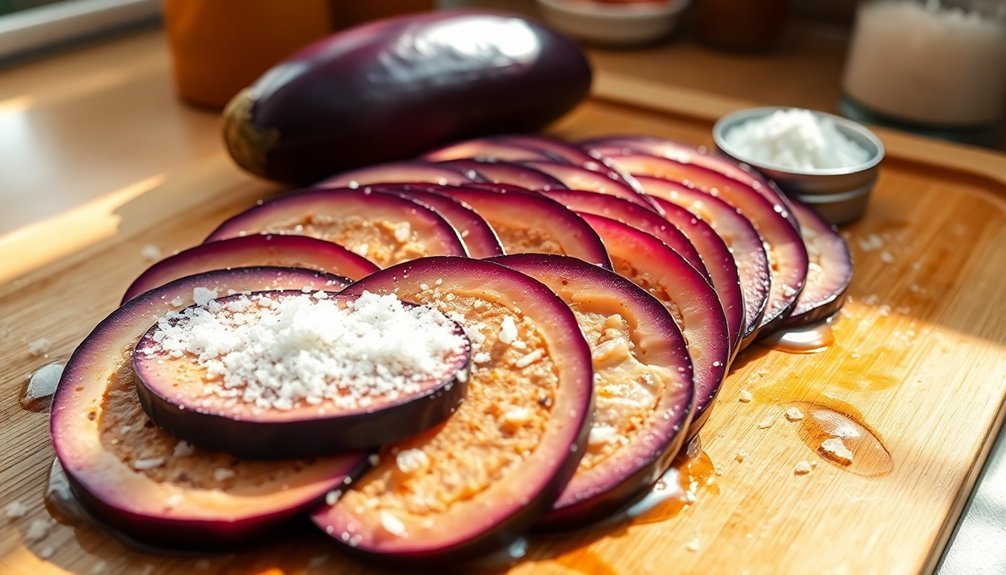To remove bitterness from eggplant, you'll find success with seven proven methods. Start by salting your sliced eggplant and letting it sit for 30 minutes to draw out bitter compounds. Try soaking the slices in milk overnight for a sweeter taste. Choose naturally less bitter varieties like Italian, white, or Japanese eggplants. Always remove seeds before cooking, as they contain concentrated bitter compounds. Harvest your eggplants young and slightly under-ripe for ideal flavor. Cook thoroughly using methods like roasting or grilling. Store properly in cool, ventilated areas to prevent bitter flavors from developing. Each technique offers unique benefits that can transform your eggplant dishes.
Traditional Salt Extraction Method

The traditional salt extraction method stands as one of the most reliable techniques for removing bitterness from eggplant. This practice, while common, is primarily beneficial for frying rather than addressing bitterness itself.
You'll need to begin by slicing your eggplant into your preferred shape, either rounds or slices, and arranging them in a colander or deep-sided plate. Cover each layer generously with coarse salt, ensuring complete coverage to effectively draw out the bitter compounds.
Next, you'll want to place a small plate or saucer on top of your salted eggplant and weigh it down with a heavy object. Let the eggplant sit for at least 30 minutes, though you'll get ideal results if you can wait 8-10 hours. During this time, store it in your refrigerator or a cool place.
You'll notice a significant amount of brown liquid (up to 1/2 cup) collecting below, which contains the bitter compounds and excess moisture.
Once the extraction is complete, gently wipe the eggplant with a damp cloth to remove excess salt, then pat it dry with paper towels. Your eggplant is now ready for cooking, and you'll find it has a creamier, more luscious texture, especially when fried.
Milk Bath Soaking Technique
While salt extraction effectively removes bitterness from eggplant, milk bath soaking offers a gentler alternative that many home cooks prefer. You'll begin by slicing your eggplant into thin 1/8-inch rounds and placing them in an airtight container. Pour whole milk over the slices until they're fully submerged, cover the container, and refrigerate. To ensure complete submersion, place a weighted plate on top of the slices.
For best results, you'll want to soak your eggplant overnight, allowing the milk to draw out bitter compounds like solanine while simultaneously tenderizing the flesh. Once soaking is complete, remove the slices and gently tap off excess moisture.
| Step | Action | Time/Temperature | Key Note | Result |
|---|---|---|---|---|
| Slice | Cut 1/8-inch rounds | Room temp | Keep uniform | Even cooking |
| Soak | Submerge in milk | Cold/overnight | Use whole milk | Removes bitterness |
| Drain | Remove from milk | Room temp | Tap gently | Reduces moisture |
| Flour | Dust with seasoned flour | Room temp | Light coating | Better browning |
| Fry | Pan-fry in hot oil | Medium-high heat | 2 min per side | Golden brown |
After flouring your slices, fry them in hot oil until golden brown, about two minutes per side. You'll know they're done when they develop a crispy exterior while maintaining a creamy interior.
Smart Variety Selection

You'll find notable differences in bitterness between traditional globe eggplants and modern cultivars like Rosa Bianca and Asian Delite, which are naturally less bitter.
For the sweetest flavor profile, opt for Italian, white, or Japanese varieties that feature thinner skins and smaller seeds compared to common American eggplants. Proper salting preparation helps draw out any remaining bitter compounds from these varieties.
Smaller varieties like Fairy Tale and Green Envy are excellent choices that offer consistently low bitterness levels while maintaining great texture and taste.
Less Bitter Eggplant Varieties
Selecting the right eggplant variety can eliminate the need for traditional debittering methods altogether. You'll find several naturally sweet varieties that'll save you time in the kitchen. The heirloom Rosa Bianca and Asian Delite are standout choices that never develop bitter flavors, while Green Envy offers one of the sweetest taste profiles available.
When choosing varieties, focus on physical characteristics that indicate less bitterness. Look for lighter-colored or white eggplants, as they're typically less bitter than darker varieties. Japanese eggplants and long, thin varieties like Thai Long Green and Louisiana Long Green consistently deliver milder flavors.
You can further guarantee sweetness by selecting male eggplants, which have a circular blossom end and fewer seeds. Choose medium-sized fruits with glossy skin, and harvest them slightly before full ripeness.
If you're growing your own, the Ping Tung variety remains bitter-free throughout all growing stages. For reliable results, consider Asian varieties like Chinese White Sword or Fairy Tale, which are bred specifically for their mild flavor profiles.
Remember that proper storage in a cool, dark place helps maintain the eggplant's sweet characteristics.
Traditional Vs Modern Types
Smart variety selection has revolutionized eggplant cultivation, marking a clear shift from traditional to modern approaches. While traditional eggplant varieties like Black Beauty and Bonica tend to be more bitter, modern varieties offer naturally sweeter alternatives that don't require extensive preparation methods.
You'll find that light-skinned varieties, including Italian, white, and Japanese eggplants, contain fewer bitter compounds than their dark-skinned counterparts. This difference stems from lower concentrations of anthocyanins and solanine, the compounds responsible for bitterness.
When you're selecting eggplants, opt for medium-sized ones that are still shiny and firm, as they'll typically have fewer seeds and less bitterness than larger, more mature specimens.
Modern understanding has also changed how you should handle eggplants. Instead of relying solely on traditional methods like salting or pressing, you can reduce bitterness through smart storage and preparation.
Store your eggplants in a cool, dark place and use them soon after purchase. For the best results, remove the seeds and skin before cooking, as these parts contain the highest concentration of bitter compounds. This approach combines variety selection with proper handling to minimize bitterness naturally.
Best Small-Size Options
Among small-sized eggplant varieties, several modern cultivars stand out for their naturally mild flavors and reduced bitterness. You'll find Japanese eggplants and Fairy Tale varieties particularly appealing, with their slender shapes and tender flesh. The Patio Baby variety, reaching only 2-3 inches in length, delivers consistently mild results when harvested young.
- Choose eggplants with glossy skin and firm texture – they're less likely to taste bitter and offer better overall flavor.
- Look for varieties with minimal seeds, like Gretel or Japanese types, as seeds contribute greatly to bitterness.
- Select compact varieties that grow in clusters, such as Fairy Tale or Patio Baby, which are perfect for container gardening and provide steady harvests.
If you're growing your own, harvest these small varieties before they're fully ripe to guarantee the mildest flavor.
While Thai eggplants can be slightly bitter, you can minimize this by picking them while they're still bright green.
For the best results, focus on varieties specifically bred for container growing, as they've been developed to produce sweeter, more tender fruits in limited spaces.
Removing Seeds Before Cooking
Proper seed removal from eggplants can greatly reduce their bitter taste before cooking. You'll find several effective methods to remove these seeds, depending on your preference and available tools.
For a manual approach, start by cutting the eggplant into manageable sections. Work methodically through each piece, using your knife to expose the seed clusters. Remove the seeds carefully with your fingers and a knife, making sure to place a tray underneath to catch any wayward seeds.
If you have a food processor, you can streamline the process. Cut off the seedless top, split the eggplant in half, and tear out the seedy flesh. Blend it with water in your food processor, then separate the seeds through a water decanting process.
For particularly stubborn seeds, you can use the water separation method. Let the eggplant soften until very ripe, then mix the flesh with water and squeeze it into a slurry. The seeds will sink to the bottom, making them easy to collect.
Whatever method you choose, make certain you thoroughly wash the extracted seeds through a sieve to remove any remaining flesh or debris before proceeding with your cooking.
Proper Harvest Timing

Timing your eggplant harvest correctly helps minimize bitterness, with peak maturity marked by glossy skin that's firm but yields slightly to pressure.
You'll want to pick your eggplants when they're young and slightly under-ripe, as overripe fruits become seedy and more bitter.
Harvesting in the morning during July or August gives you ideal flavor, and remember to use scissors or a knife rather than pulling the fruit from the plant.
Peak Maturity Signs
Knowing when to harvest your eggplants is vital for minimizing bitterness and ensuring peak flavor.
You'll want to monitor your plants closely once they've reached their expected maturity window, typically 65-100 days after seeding. The fruits should develop within 7-14 days after you notice the characteristic pale purple, star-shaped flowers on your plants.
To determine if your eggplants are at peak maturity, look for these important indicators:
- Size and Firmness: Your eggplants should match the expected size for their variety and feel plump yet firm. When you press the skin with your fingernail, it should bounce back quickly.
- Skin Appearance: Look for a glossy, uniform color without any dull patches. The skin should be smooth and unblemished, free from handling defects or growth irregularities.
- Calyx Condition: Check the leafy crown (calyx) at the top of the fruit – it should be fresh and green, not brown or withered.
Don't wait too long to harvest, as overripe eggplants become bitter and develop tough seeds.
Harvest when the fruit is mature but still young for the best flavor and texture.
Ripe vs. Overripe
To get the best flavor from your eggplants, you'll need to distinguish between ripe and overripe fruit. A perfectly ripe eggplant has firm flesh, glossy skin, and maintains its expected size for its variety. You'll notice the skin is taut and shiny, without any wrinkles or blemishes.
If you let your eggplant become overripe, you'll encounter several undesirable characteristics. The skin becomes dull and may wrinkle, while the flesh turns hard with large, tough seeds. These seeds greatly increase the fruit's bitterness, making it less enjoyable to eat.
Overripe eggplants also attract more garden pests and contain higher levels of bitter compounds like solanine and anthocyanin.
To prevent your eggplants from becoming overripe, harvest them slightly before full maturity. Use sharp scissors or pruners to clip the fruit from the plant, and check your garden regularly to catch them at the right time.
Once harvested, store them in a cool, dry place to slow down the ripening process. If weather conditions threaten your crop, you can harvest early and let them finish ripening indoors.
Best Picking Conditions
A successful eggplant harvest depends heavily on recognizing the ideal moment to pick your fruit. You'll want to monitor your eggplants when they reach about 6-8 inches in length, or roughly the size of your hand. The skin should display a glossy sheen and feel firm when you gently press it with your fingernail. If you're growing mini or Asian varieties, they'll mature faster than standard varieties.
For the best harvest results, follow these key indicators:
- Visual cues: Look for consistent coloring and a reflective surface that shines when held up to light.
- Size and firmness: The fruit should be plump but firm, never soft or spongy.
- Timing considerations: Expect maturity between 55-70 days after planting, depending on variety.
When you're ready to harvest, don't twist the fruit off the plant. Instead, use sharp scissors or garden shears to cut the stem, and wear gloves to protect yourself from thorns.
Remember that regular harvesting encourages more fruit production, so check your plants frequently once they start producing.
Maintain soil temperatures around 70°F for ideal growth and protect young plants from frost with row covers.
Strategic Cooking Methods
While proper preparation techniques lay the foundation, strategic cooking methods play an essential role in minimizing eggplant's natural bitterness. You'll want to confirm you're cooking your eggplant thoroughly, as undercooked pieces often retain their bitter compounds, especially in thick-skinned varieties.
You can choose from several effective cooking techniques. Roasting, grilling, and sautéing are particularly successful at balancing out the eggplant's flavors. When you're cooking, make certain to give the eggplant enough time to break down its bitter compounds completely. You'll know it's ready when the flesh becomes tender and creamy.
To enhance your results, you can combine cooking methods with other preparation techniques. If you've salted or soaked your eggplant beforehand, dry it thoroughly before cooking to achieve better texture.
Adding marinades or complementary sauces during cooking will help mask any remaining bitterness. For best results, you'll want to time your cooking carefully – neither rushing the process nor overcooking to the point of mushiness. The goal is to achieve that perfect balance where the eggplant is thoroughly cooked but still maintains its structural integrity.
Fresh Storage Practices

Proper storage practices greatly impact eggplant's bitterness and overall quality. You'll want to store your eggplants in a cool, well-ventilated area with temperatures between 46°F and 54°F.
Don't store them in the refrigerator unless you plan to use them within three days, as temperatures below 41°F can cause chilling injuries and affect their taste.
Keep your eggplants away from ethylene-producing fruits like bananas, tomatoes, and melons, as they're quite sensitive to this ripening hormone.
Maintain a relative humidity of 90-95% while ensuring good air circulation to prevent moisture buildup and decay.
- Store eggplants at room temperature in a vented bowl or container
- Don't seal them in plastic bags, which can trap moisture and accelerate spoilage
- Check regularly for signs of decay and remove any damaged specimens immediately
For ideal results, use your eggplants as soon as possible after purchase.
If you need to store them, place them in a cool spot away from direct sunlight.
Frequently Asked Questions
Can Frozen Eggplant Become Less Bitter When Thawed?
Yes, you'll find that frozen eggplant becomes less bitter when thawed. When you freeze and thaw the slices, then press out the water, you'll remove bitter compounds. It's a quick fix for bitterness.
Does Microwave Cooking Affect the Bitterness Level of Eggplant?
While you'll find microwaving doesn't directly reduce eggplant's bitterness, it can help remove moisture when combined with salting. The process mainly affects texture rather than changing the bitter compounds themselves.
Are Male Eggplants Less Bitter Than Female Ones?
You can't determine bitterness by "male" or "female" eggplants because it's a misconception – eggplants aren't gendered. Instead, bitterness depends on the fruit's age, size, variety, and growing conditions.
Will Adding Sugar While Cooking Help Reduce Eggplant Bitterness?
No, adding sugar won't actually reduce your eggplant's bitterness. While it might mask the taste slightly, you'll get better results by salting, chilling, or soaking in milk before cooking your eggplant.
Do Organic Eggplants Contain More or Less Bitter Compounds?
You won't find any significant difference in bitter compounds between organic and non-organic eggplants. The bitterness depends more on factors like variety, size, age, and growing conditions than the farming method.
In Summary
You'll find that mastering these seven methods transforms your eggplant dishes from bitter disappointments to delicious meals. Whether you're using the traditional salt technique or trying the milk bath approach, each method offers unique benefits. By combining proper selection, storage, and preparation techniques, you'll consistently achieve sweet, tender eggplant that'll make your recipes shine. Don't let bitterness stop you from enjoying this versatile vegetable.





Leave a Reply